Pollinator Paradise in Crisis
Tammy and I have been growing at the Genuine Faux Farm since 2004. Prior to that, we did our fair share of gardening. We'd like to think that we have some idea what attracts pollinators. We'd also like to believe that we know when pollinator numbers are lower than they should be.
Folks. The numbers are low and they are declining on our farm. We suspect this is also true throughout the state of Iowa and probably most of the world today.

We have not seen this type of black honey bee on the farm before.
While it is true that we do continue to observe many interesting creatures on our 15 acres of "Pollinator Paradise" (or so we like to call it), we have been alarmed that we can work so hard to provide habitat and NOT see certain flowers swarming with all sorts of pollinating insects.
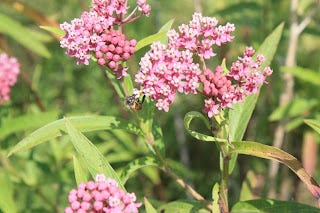
Note the honeybee on the flowers.
For example, we planted several Swamp Milkweed, courtesy of K&K Gardens in Hawkeye, Iowa. Monarchs should like them, as should milkweed bugs. While we have had some monarchs on the common milkweed on the farm, we've only seen a couple of honeybees on these new plants - even though the plants seem to be doing well and blooming nicely.
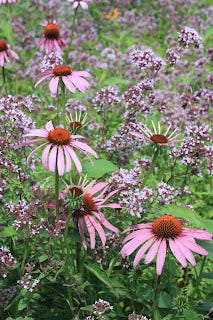
At present, the oregano is in full bloom. Oregano and many other flowering herbs are known to attract bees of all sorts and coneflowers are often listed as a good pollinator attracting plant. Everything you read (and our own experience) tells us that diverse blooms over a long period of time should provide plenty of habitat to keep the pollinators healthy and happy. And yet, there wasn't much of a buzz going on with the flowers I found in this picture.
The wind was light. It was mostly sunny with some clouds to keep things from being too hot. The temperatures were reasonable and I took this picture during a time of the day when past experience has shown me that pollinators would really be out an about.
I stood still for a while and waited to see if I was just not being patient enough. Yes. There were some pollinators in the patch. Perhaps it is just a small patch? Maybe not big enough to elicit a response?
You decide. Is this patch big enough?
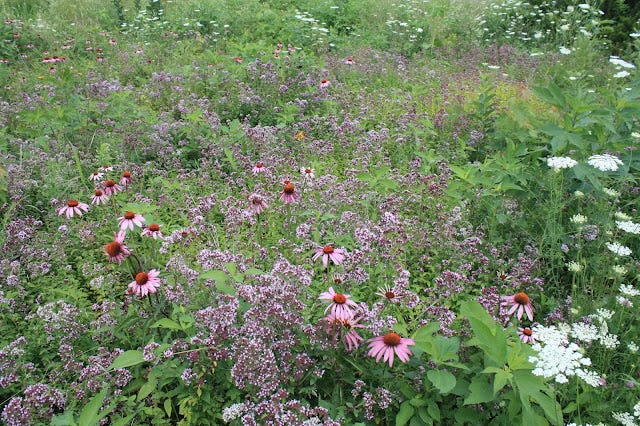
Not seen in the picture are the clover mixed in with the Queen Anne's Lace, the Rudbekia to the left and phlox further back and to the left. And, that's just what is flowering now. It's a good area for pollinators. We've seen more activity in this area in the past. So, something is going on here.
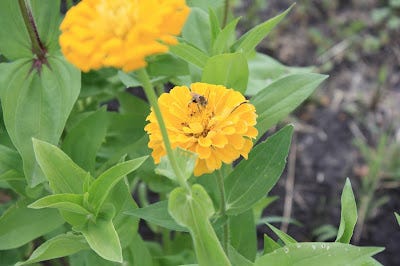
A native bee in the zinnia.
The zinnias are just getting going and we know by experience that they are also very good at attracting a range of pollinators from bees to bumblebees to butterflies.
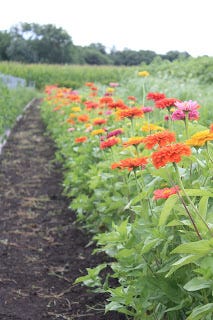
It's not like we don't grow enough of them to make a difference (see one of our rows at the right). We are particularly disturbed by the relatively low numbers of bumblebees this year. We are pretty friendly to bumblers since we allow active nests to remain in a couple of our outbuildings. Frankly, we are so worried about their decline that we wouldn't think of evicting them.
Perhaps we will see an explosion of activity in August. In fact, August is usually the busiest month on our farm for bumblebees and other native bees. But, we still feel there is a problem here.
If you are not sold that there is a problem, consider this:
Zucchini and other squash are pollinated by Squash Bees (a native bee) and other bees (who are less efficient at pollinating than squash bees). A squash flower needs to be visited 6 to 10 times by Squash Bees in the early morning to set fruit properly (more visits by other pollinators). Our zucchini and summer squash production have gone down per row foot over the years as we have seen more instances of fruit that were not fully pollinated. These fruit tend to not fill out properly or will yellow and rot off. We have seen much more evidence of insufficient pollination the past three to five years in our summer squashes.
We will grant you that weather conditions can prevent visits by pollinators, so it is not unusual to have a period of time every season where there are more cull fruit due to poor pollination. But, there is a difference between seasonal variability and trends across multiple seasons.
We have been convinced that there is a problem that needs addressing. One of our responses on our farm has been to increase the pollinator habitat and maintain it as best as we can. Even with all of this effort, we fear we are losing the battle.
What are the observations on other fronts? We would love to hear from you.



